Business Law Report: Key Sources of Law and UK Business Structures
VerifiedAdded on 2023/06/10
|8
|2468
|212
Report
AI Summary
This report provides a comprehensive overview of business law within the UK, specifically addressing the legal context for business organizations. It begins by defining key legal concepts and their relevance to business operations, followed by an exploration of various business structures, including sole traders, general partnerships, limited partnerships, and limited liability companies. The report analyzes the advantages and disadvantages of each structure, offering insights into their suitability for different business needs. A significant portion of the report is dedicated to a case study of IOM Solutions, a company selling electrical parts. Based on the analysis of different business structures, the report recommends a partnership business as the most appropriate legal structure for IOM Solutions, considering factors such as the need for shared expertise, financial resources, and decision-making capabilities. The report concludes by summarizing the key findings and emphasizing the importance of adhering to business law to ensure smooth operations and avoid legal consequences.
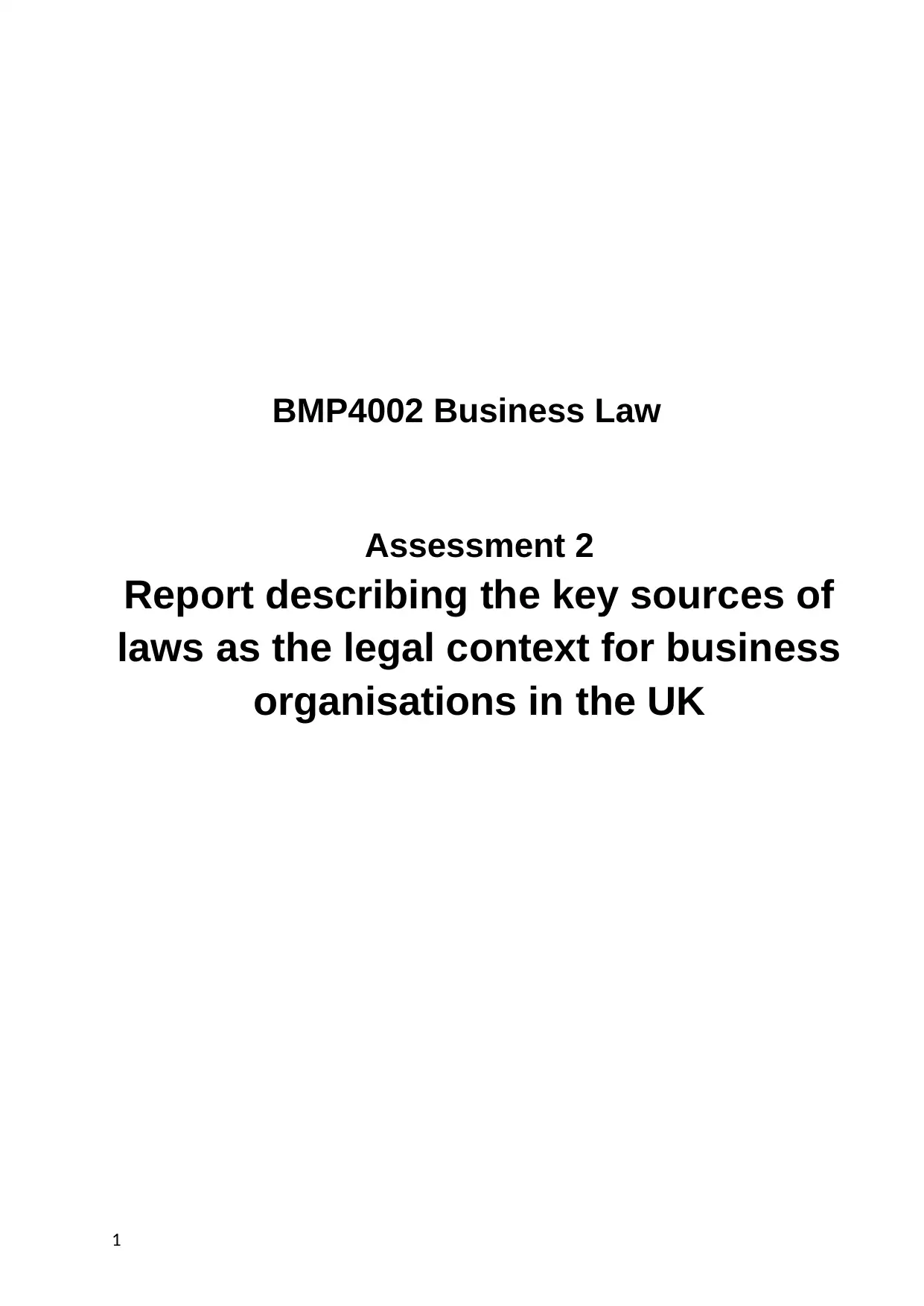
BMP4002 Business Law
Assessment 2
Report describing the key sources of
laws as the legal context for business
organisations in the UK
1
Assessment 2
Report describing the key sources of
laws as the legal context for business
organisations in the UK
1
Paraphrase This Document
Need a fresh take? Get an instant paraphrase of this document with our AI Paraphraser

Table of Contents
Introduction ...............................................................................................................................3
Businesses & Organisations in the UK........................................................................................3
The legal business structure of UK companies..........................................................................5
Recommendations for IOM Solutions........................................................................................7
Conclusion..................................................................................................................................7
References..................................................................................................................................8
Books and Journals:..........................................................................................................8
2
Introduction ...............................................................................................................................3
Businesses & Organisations in the UK........................................................................................3
The legal business structure of UK companies..........................................................................5
Recommendations for IOM Solutions........................................................................................7
Conclusion..................................................................................................................................7
References..................................................................................................................................8
Books and Journals:..........................................................................................................8
2
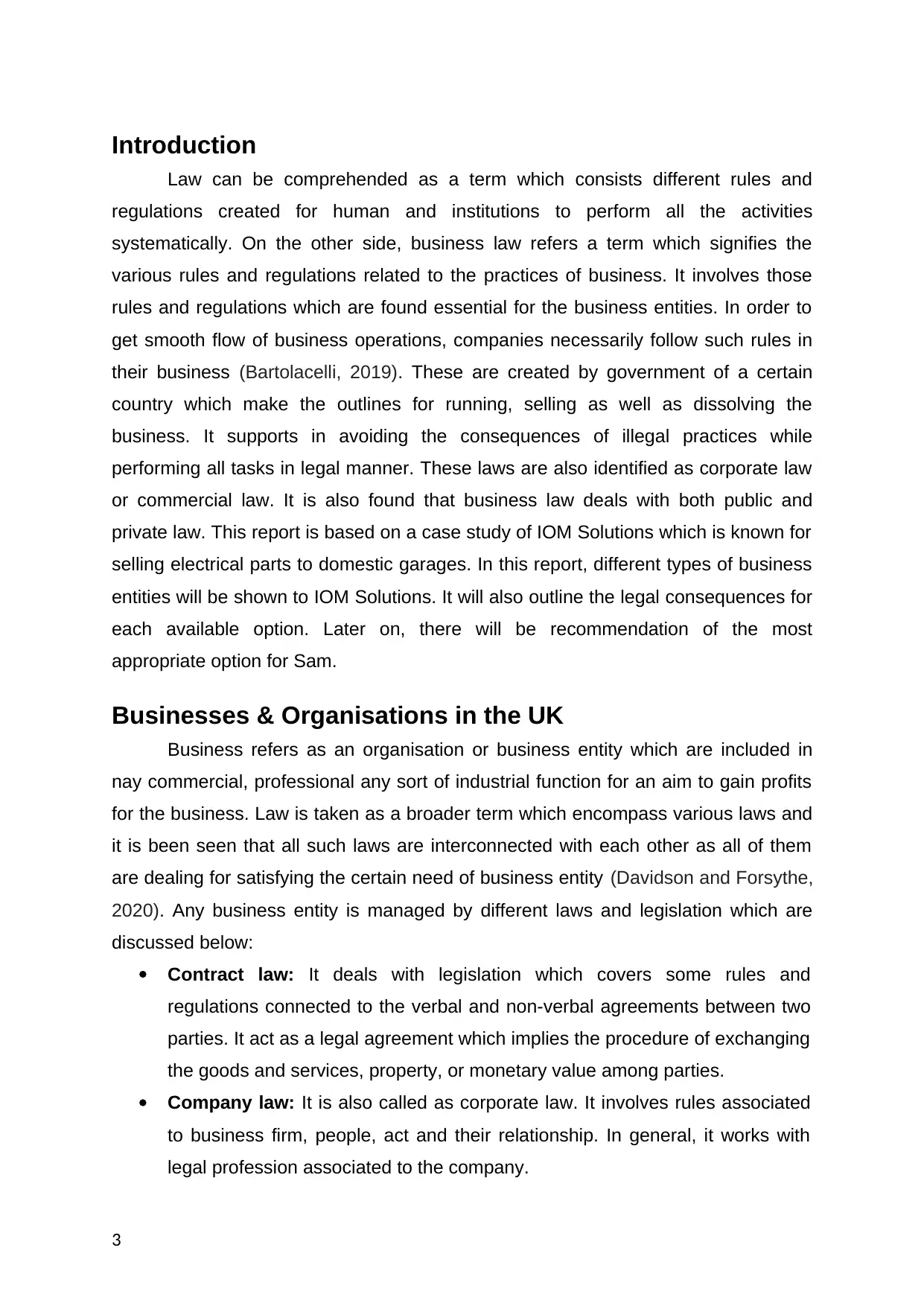
Introduction
Law can be comprehended as a term which consists different rules and
regulations created for human and institutions to perform all the activities
systematically. On the other side, business law refers a term which signifies the
various rules and regulations related to the practices of business. It involves those
rules and regulations which are found essential for the business entities. In order to
get smooth flow of business operations, companies necessarily follow such rules in
their business (Bartolacelli, 2019). These are created by government of a certain
country which make the outlines for running, selling as well as dissolving the
business. It supports in avoiding the consequences of illegal practices while
performing all tasks in legal manner. These laws are also identified as corporate law
or commercial law. It is also found that business law deals with both public and
private law. This report is based on a case study of IOM Solutions which is known for
selling electrical parts to domestic garages. In this report, different types of business
entities will be shown to IOM Solutions. It will also outline the legal consequences for
each available option. Later on, there will be recommendation of the most
appropriate option for Sam.
Businesses & Organisations in the UK
Business refers as an organisation or business entity which are included in
nay commercial, professional any sort of industrial function for an aim to gain profits
for the business. Law is taken as a broader term which encompass various laws and
it is been seen that all such laws are interconnected with each other as all of them
are dealing for satisfying the certain need of business entity (Davidson and Forsythe,
2020). Any business entity is managed by different laws and legislation which are
discussed below:
Contract law: It deals with legislation which covers some rules and
regulations connected to the verbal and non-verbal agreements between two
parties. It act as a legal agreement which implies the procedure of exchanging
the goods and services, property, or monetary value among parties.
Company law: It is also called as corporate law. It involves rules associated
to business firm, people, act and their relationship. In general, it works with
legal profession associated to the company.
3
Law can be comprehended as a term which consists different rules and
regulations created for human and institutions to perform all the activities
systematically. On the other side, business law refers a term which signifies the
various rules and regulations related to the practices of business. It involves those
rules and regulations which are found essential for the business entities. In order to
get smooth flow of business operations, companies necessarily follow such rules in
their business (Bartolacelli, 2019). These are created by government of a certain
country which make the outlines for running, selling as well as dissolving the
business. It supports in avoiding the consequences of illegal practices while
performing all tasks in legal manner. These laws are also identified as corporate law
or commercial law. It is also found that business law deals with both public and
private law. This report is based on a case study of IOM Solutions which is known for
selling electrical parts to domestic garages. In this report, different types of business
entities will be shown to IOM Solutions. It will also outline the legal consequences for
each available option. Later on, there will be recommendation of the most
appropriate option for Sam.
Businesses & Organisations in the UK
Business refers as an organisation or business entity which are included in
nay commercial, professional any sort of industrial function for an aim to gain profits
for the business. Law is taken as a broader term which encompass various laws and
it is been seen that all such laws are interconnected with each other as all of them
are dealing for satisfying the certain need of business entity (Davidson and Forsythe,
2020). Any business entity is managed by different laws and legislation which are
discussed below:
Contract law: It deals with legislation which covers some rules and
regulations connected to the verbal and non-verbal agreements between two
parties. It act as a legal agreement which implies the procedure of exchanging
the goods and services, property, or monetary value among parties.
Company law: It is also called as corporate law. It involves rules associated
to business firm, people, act and their relationship. In general, it works with
legal profession associated to the company.
3
⊘ This is a preview!⊘
Do you want full access?
Subscribe today to unlock all pages.

Trusted by 1+ million students worldwide
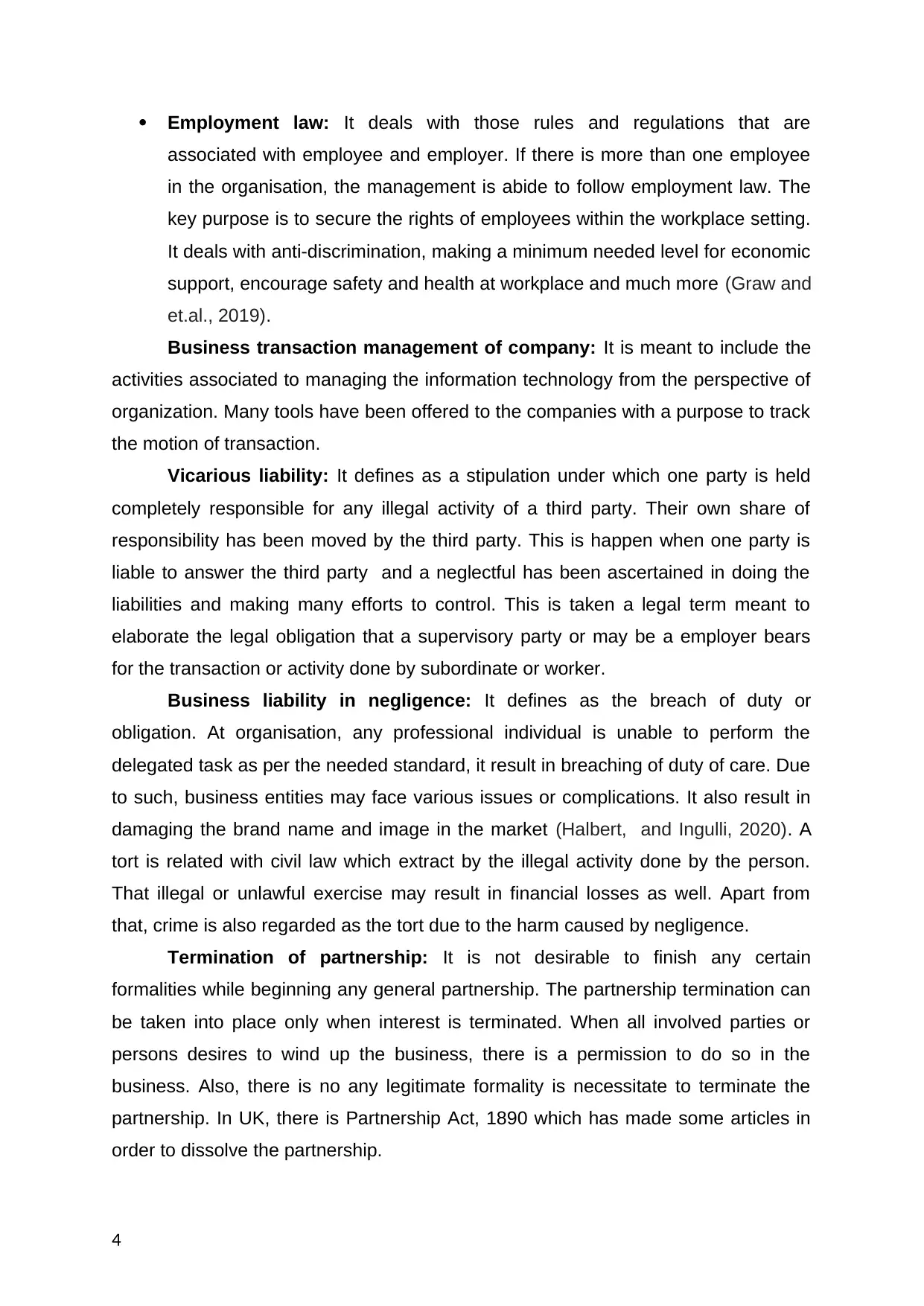
Employment law: It deals with those rules and regulations that are
associated with employee and employer. If there is more than one employee
in the organisation, the management is abide to follow employment law. The
key purpose is to secure the rights of employees within the workplace setting.
It deals with anti-discrimination, making a minimum needed level for economic
support, encourage safety and health at workplace and much more (Graw and
et.al., 2019).
Business transaction management of company: It is meant to include the
activities associated to managing the information technology from the perspective of
organization. Many tools have been offered to the companies with a purpose to track
the motion of transaction.
Vicarious liability: It defines as a stipulation under which one party is held
completely responsible for any illegal activity of a third party. Their own share of
responsibility has been moved by the third party. This is happen when one party is
liable to answer the third party and a neglectful has been ascertained in doing the
liabilities and making many efforts to control. This is taken a legal term meant to
elaborate the legal obligation that a supervisory party or may be a employer bears
for the transaction or activity done by subordinate or worker.
Business liability in negligence: It defines as the breach of duty or
obligation. At organisation, any professional individual is unable to perform the
delegated task as per the needed standard, it result in breaching of duty of care. Due
to such, business entities may face various issues or complications. It also result in
damaging the brand name and image in the market (Halbert, and Ingulli, 2020). A
tort is related with civil law which extract by the illegal activity done by the person.
That illegal or unlawful exercise may result in financial losses as well. Apart from
that, crime is also regarded as the tort due to the harm caused by negligence.
Termination of partnership: It is not desirable to finish any certain
formalities while beginning any general partnership. The partnership termination can
be taken into place only when interest is terminated. When all involved parties or
persons desires to wind up the business, there is a permission to do so in the
business. Also, there is no any legitimate formality is necessitate to terminate the
partnership. In UK, there is Partnership Act, 1890 which has made some articles in
order to dissolve the partnership.
4
associated with employee and employer. If there is more than one employee
in the organisation, the management is abide to follow employment law. The
key purpose is to secure the rights of employees within the workplace setting.
It deals with anti-discrimination, making a minimum needed level for economic
support, encourage safety and health at workplace and much more (Graw and
et.al., 2019).
Business transaction management of company: It is meant to include the
activities associated to managing the information technology from the perspective of
organization. Many tools have been offered to the companies with a purpose to track
the motion of transaction.
Vicarious liability: It defines as a stipulation under which one party is held
completely responsible for any illegal activity of a third party. Their own share of
responsibility has been moved by the third party. This is happen when one party is
liable to answer the third party and a neglectful has been ascertained in doing the
liabilities and making many efforts to control. This is taken a legal term meant to
elaborate the legal obligation that a supervisory party or may be a employer bears
for the transaction or activity done by subordinate or worker.
Business liability in negligence: It defines as the breach of duty or
obligation. At organisation, any professional individual is unable to perform the
delegated task as per the needed standard, it result in breaching of duty of care. Due
to such, business entities may face various issues or complications. It also result in
damaging the brand name and image in the market (Halbert, and Ingulli, 2020). A
tort is related with civil law which extract by the illegal activity done by the person.
That illegal or unlawful exercise may result in financial losses as well. Apart from
that, crime is also regarded as the tort due to the harm caused by negligence.
Termination of partnership: It is not desirable to finish any certain
formalities while beginning any general partnership. The partnership termination can
be taken into place only when interest is terminated. When all involved parties or
persons desires to wind up the business, there is a permission to do so in the
business. Also, there is no any legitimate formality is necessitate to terminate the
partnership. In UK, there is Partnership Act, 1890 which has made some articles in
order to dissolve the partnership.
4
Paraphrase This Document
Need a fresh take? Get an instant paraphrase of this document with our AI Paraphraser
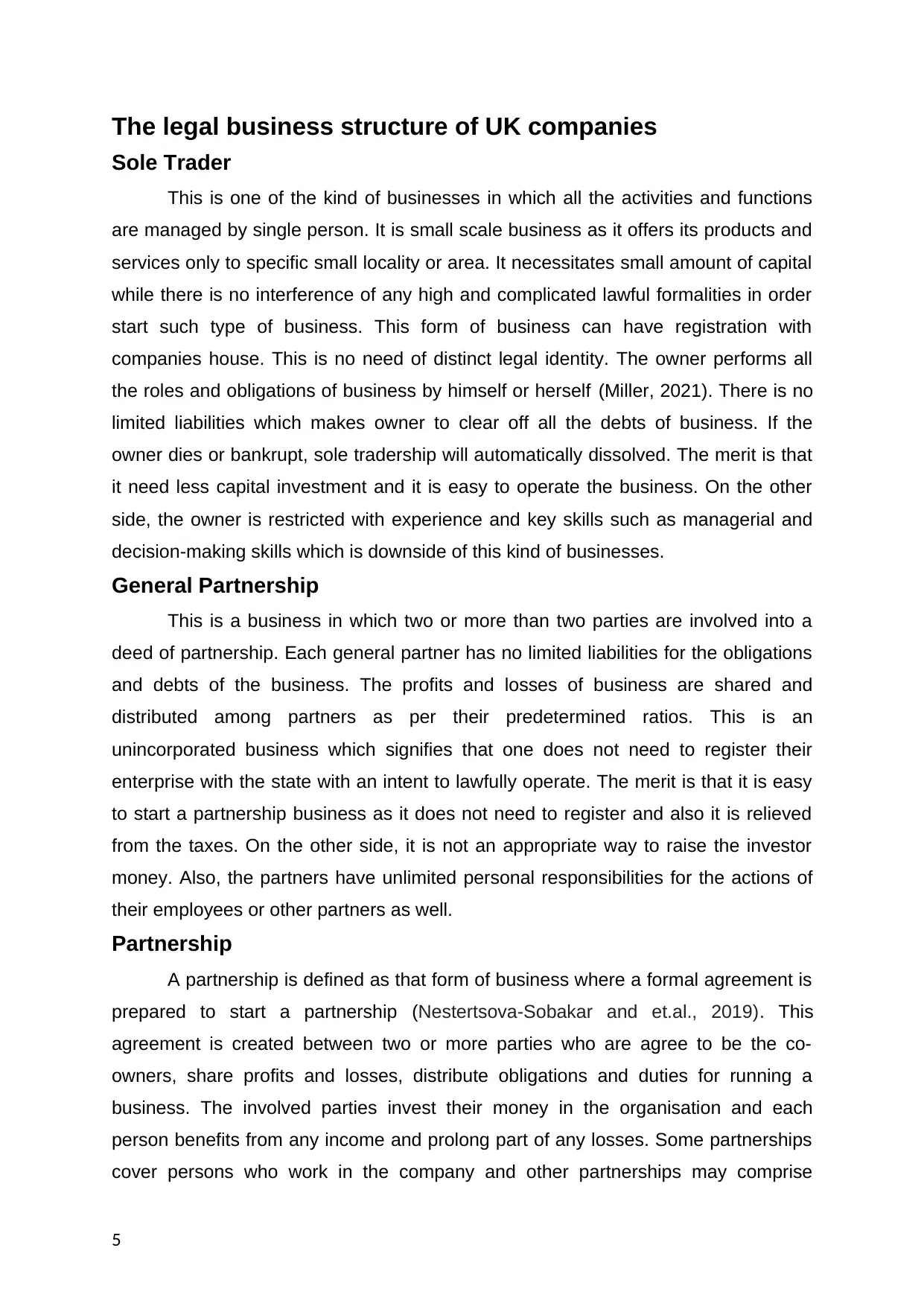
The legal business structure of UK companies
Sole Trader
This is one of the kind of businesses in which all the activities and functions
are managed by single person. It is small scale business as it offers its products and
services only to specific small locality or area. It necessitates small amount of capital
while there is no interference of any high and complicated lawful formalities in order
start such type of business. This form of business can have registration with
companies house. This is no need of distinct legal identity. The owner performs all
the roles and obligations of business by himself or herself (Miller, 2021). There is no
limited liabilities which makes owner to clear off all the debts of business. If the
owner dies or bankrupt, sole tradership will automatically dissolved. The merit is that
it need less capital investment and it is easy to operate the business. On the other
side, the owner is restricted with experience and key skills such as managerial and
decision-making skills which is downside of this kind of businesses.
General Partnership
This is a business in which two or more than two parties are involved into a
deed of partnership. Each general partner has no limited liabilities for the obligations
and debts of the business. The profits and losses of business are shared and
distributed among partners as per their predetermined ratios. This is an
unincorporated business which signifies that one does not need to register their
enterprise with the state with an intent to lawfully operate. The merit is that it is easy
to start a partnership business as it does not need to register and also it is relieved
from the taxes. On the other side, it is not an appropriate way to raise the investor
money. Also, the partners have unlimited personal responsibilities for the actions of
their employees or other partners as well.
Partnership
A partnership is defined as that form of business where a formal agreement is
prepared to start a partnership (Nestertsova-Sobakar and et.al., 2019). This
agreement is created between two or more parties who are agree to be the co-
owners, share profits and losses, distribute obligations and duties for running a
business. The involved parties invest their money in the organisation and each
person benefits from any income and prolong part of any losses. Some partnerships
cover persons who work in the company and other partnerships may comprise
5
Sole Trader
This is one of the kind of businesses in which all the activities and functions
are managed by single person. It is small scale business as it offers its products and
services only to specific small locality or area. It necessitates small amount of capital
while there is no interference of any high and complicated lawful formalities in order
start such type of business. This form of business can have registration with
companies house. This is no need of distinct legal identity. The owner performs all
the roles and obligations of business by himself or herself (Miller, 2021). There is no
limited liabilities which makes owner to clear off all the debts of business. If the
owner dies or bankrupt, sole tradership will automatically dissolved. The merit is that
it need less capital investment and it is easy to operate the business. On the other
side, the owner is restricted with experience and key skills such as managerial and
decision-making skills which is downside of this kind of businesses.
General Partnership
This is a business in which two or more than two parties are involved into a
deed of partnership. Each general partner has no limited liabilities for the obligations
and debts of the business. The profits and losses of business are shared and
distributed among partners as per their predetermined ratios. This is an
unincorporated business which signifies that one does not need to register their
enterprise with the state with an intent to lawfully operate. The merit is that it is easy
to start a partnership business as it does not need to register and also it is relieved
from the taxes. On the other side, it is not an appropriate way to raise the investor
money. Also, the partners have unlimited personal responsibilities for the actions of
their employees or other partners as well.
Partnership
A partnership is defined as that form of business where a formal agreement is
prepared to start a partnership (Nestertsova-Sobakar and et.al., 2019). This
agreement is created between two or more parties who are agree to be the co-
owners, share profits and losses, distribute obligations and duties for running a
business. The involved parties invest their money in the organisation and each
person benefits from any income and prolong part of any losses. Some partnerships
cover persons who work in the company and other partnerships may comprise
5
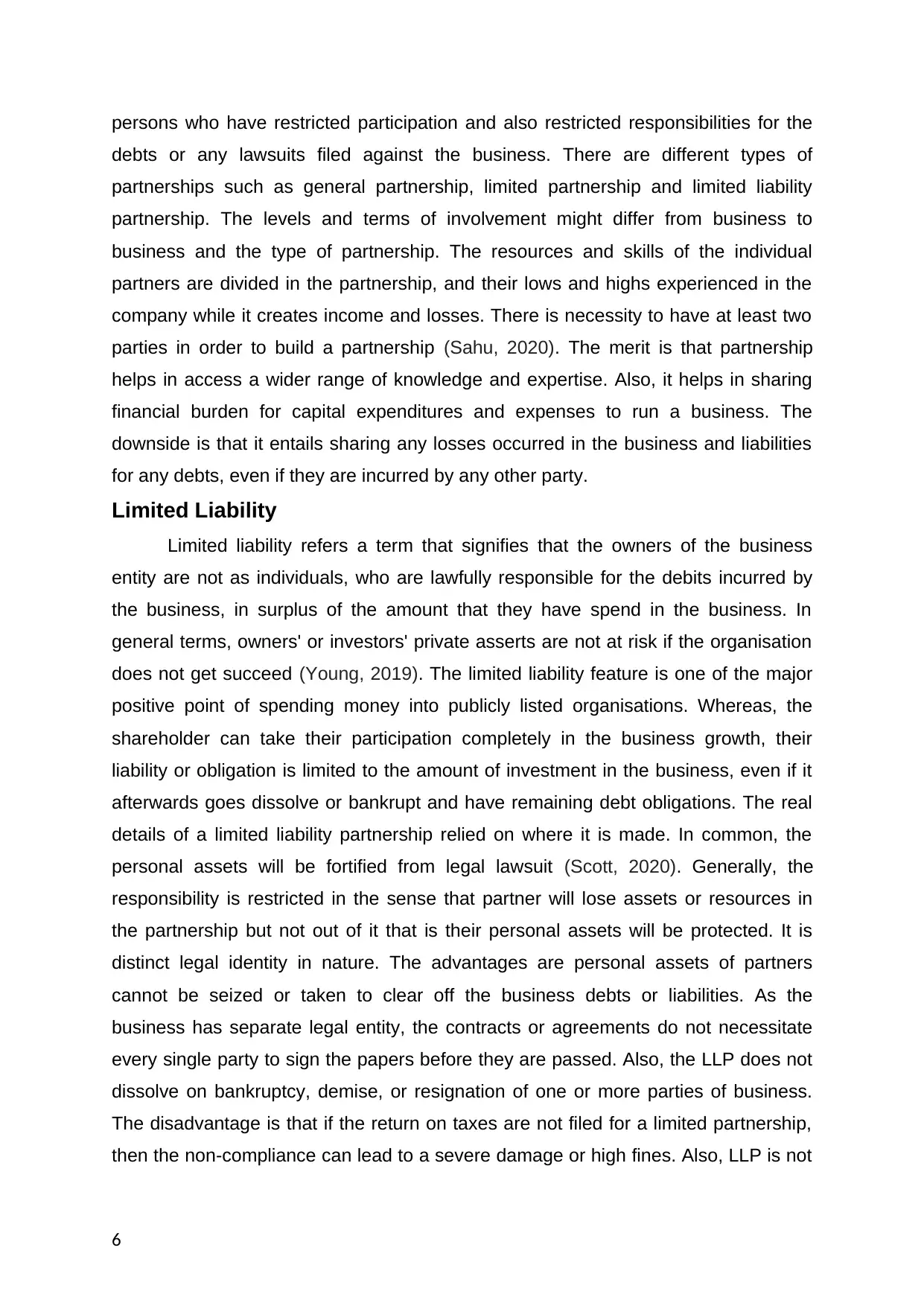
persons who have restricted participation and also restricted responsibilities for the
debts or any lawsuits filed against the business. There are different types of
partnerships such as general partnership, limited partnership and limited liability
partnership. The levels and terms of involvement might differ from business to
business and the type of partnership. The resources and skills of the individual
partners are divided in the partnership, and their lows and highs experienced in the
company while it creates income and losses. There is necessity to have at least two
parties in order to build a partnership (Sahu, 2020). The merit is that partnership
helps in access a wider range of knowledge and expertise. Also, it helps in sharing
financial burden for capital expenditures and expenses to run a business. The
downside is that it entails sharing any losses occurred in the business and liabilities
for any debts, even if they are incurred by any other party.
Limited Liability
Limited liability refers a term that signifies that the owners of the business
entity are not as individuals, who are lawfully responsible for the debits incurred by
the business, in surplus of the amount that they have spend in the business. In
general terms, owners' or investors' private asserts are not at risk if the organisation
does not get succeed (Young, 2019). The limited liability feature is one of the major
positive point of spending money into publicly listed organisations. Whereas, the
shareholder can take their participation completely in the business growth, their
liability or obligation is limited to the amount of investment in the business, even if it
afterwards goes dissolve or bankrupt and have remaining debt obligations. The real
details of a limited liability partnership relied on where it is made. In common, the
personal assets will be fortified from legal lawsuit (Scott, 2020). Generally, the
responsibility is restricted in the sense that partner will lose assets or resources in
the partnership but not out of it that is their personal assets will be protected. It is
distinct legal identity in nature. The advantages are personal assets of partners
cannot be seized or taken to clear off the business debts or liabilities. As the
business has separate legal entity, the contracts or agreements do not necessitate
every single party to sign the papers before they are passed. Also, the LLP does not
dissolve on bankruptcy, demise, or resignation of one or more parties of business.
The disadvantage is that if the return on taxes are not filed for a limited partnership,
then the non-compliance can lead to a severe damage or high fines. Also, LLP is not
6
debts or any lawsuits filed against the business. There are different types of
partnerships such as general partnership, limited partnership and limited liability
partnership. The levels and terms of involvement might differ from business to
business and the type of partnership. The resources and skills of the individual
partners are divided in the partnership, and their lows and highs experienced in the
company while it creates income and losses. There is necessity to have at least two
parties in order to build a partnership (Sahu, 2020). The merit is that partnership
helps in access a wider range of knowledge and expertise. Also, it helps in sharing
financial burden for capital expenditures and expenses to run a business. The
downside is that it entails sharing any losses occurred in the business and liabilities
for any debts, even if they are incurred by any other party.
Limited Liability
Limited liability refers a term that signifies that the owners of the business
entity are not as individuals, who are lawfully responsible for the debits incurred by
the business, in surplus of the amount that they have spend in the business. In
general terms, owners' or investors' private asserts are not at risk if the organisation
does not get succeed (Young, 2019). The limited liability feature is one of the major
positive point of spending money into publicly listed organisations. Whereas, the
shareholder can take their participation completely in the business growth, their
liability or obligation is limited to the amount of investment in the business, even if it
afterwards goes dissolve or bankrupt and have remaining debt obligations. The real
details of a limited liability partnership relied on where it is made. In common, the
personal assets will be fortified from legal lawsuit (Scott, 2020). Generally, the
responsibility is restricted in the sense that partner will lose assets or resources in
the partnership but not out of it that is their personal assets will be protected. It is
distinct legal identity in nature. The advantages are personal assets of partners
cannot be seized or taken to clear off the business debts or liabilities. As the
business has separate legal entity, the contracts or agreements do not necessitate
every single party to sign the papers before they are passed. Also, the LLP does not
dissolve on bankruptcy, demise, or resignation of one or more parties of business.
The disadvantage is that if the return on taxes are not filed for a limited partnership,
then the non-compliance can lead to a severe damage or high fines. Also, LLP is not
6
⊘ This is a preview!⊘
Do you want full access?
Subscribe today to unlock all pages.

Trusted by 1+ million students worldwide
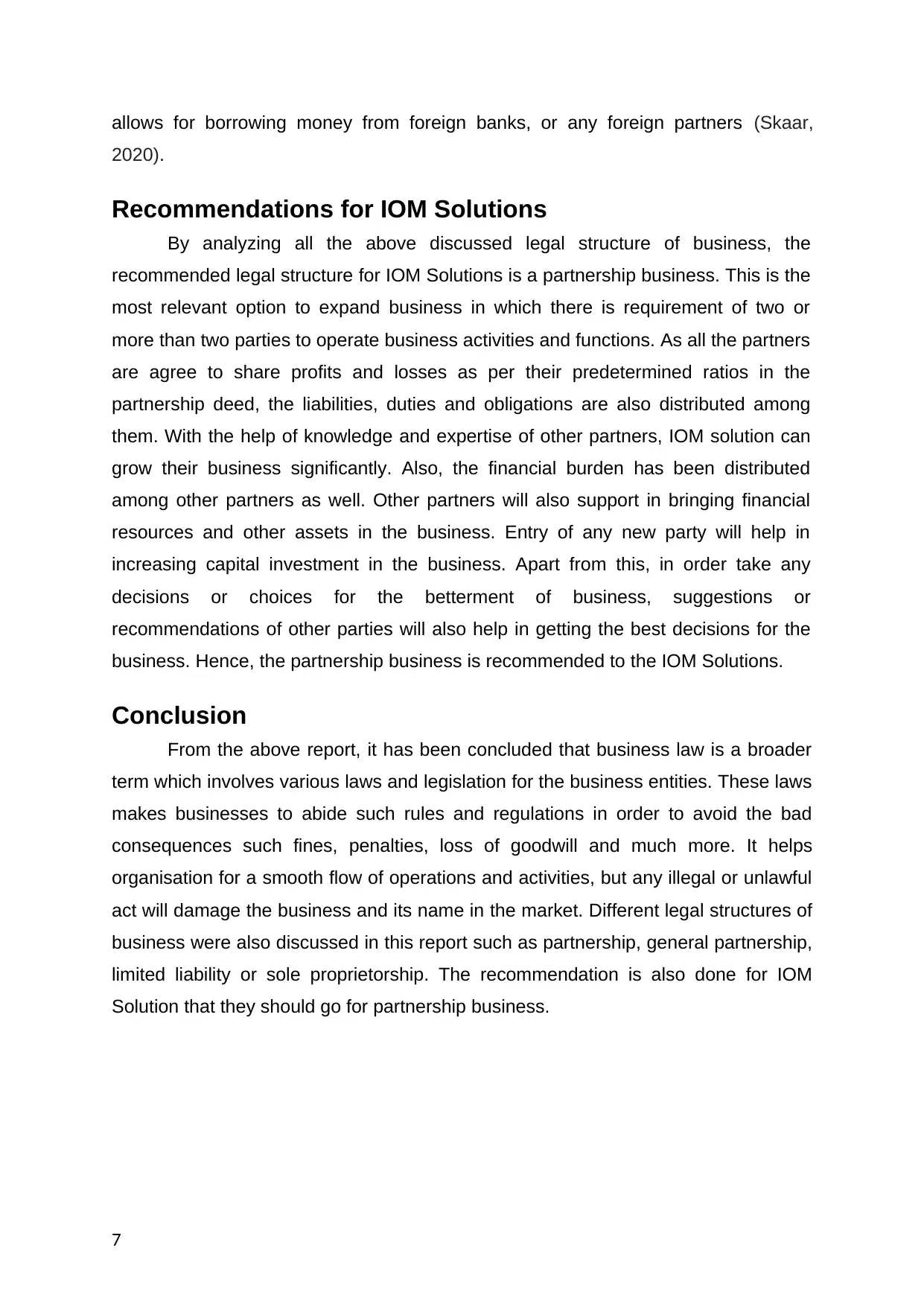
allows for borrowing money from foreign banks, or any foreign partners (Skaar,
2020).
Recommendations for IOM Solutions
By analyzing all the above discussed legal structure of business, the
recommended legal structure for IOM Solutions is a partnership business. This is the
most relevant option to expand business in which there is requirement of two or
more than two parties to operate business activities and functions. As all the partners
are agree to share profits and losses as per their predetermined ratios in the
partnership deed, the liabilities, duties and obligations are also distributed among
them. With the help of knowledge and expertise of other partners, IOM solution can
grow their business significantly. Also, the financial burden has been distributed
among other partners as well. Other partners will also support in bringing financial
resources and other assets in the business. Entry of any new party will help in
increasing capital investment in the business. Apart from this, in order take any
decisions or choices for the betterment of business, suggestions or
recommendations of other parties will also help in getting the best decisions for the
business. Hence, the partnership business is recommended to the IOM Solutions.
Conclusion
From the above report, it has been concluded that business law is a broader
term which involves various laws and legislation for the business entities. These laws
makes businesses to abide such rules and regulations in order to avoid the bad
consequences such fines, penalties, loss of goodwill and much more. It helps
organisation for a smooth flow of operations and activities, but any illegal or unlawful
act will damage the business and its name in the market. Different legal structures of
business were also discussed in this report such as partnership, general partnership,
limited liability or sole proprietorship. The recommendation is also done for IOM
Solution that they should go for partnership business.
7
2020).
Recommendations for IOM Solutions
By analyzing all the above discussed legal structure of business, the
recommended legal structure for IOM Solutions is a partnership business. This is the
most relevant option to expand business in which there is requirement of two or
more than two parties to operate business activities and functions. As all the partners
are agree to share profits and losses as per their predetermined ratios in the
partnership deed, the liabilities, duties and obligations are also distributed among
them. With the help of knowledge and expertise of other partners, IOM solution can
grow their business significantly. Also, the financial burden has been distributed
among other partners as well. Other partners will also support in bringing financial
resources and other assets in the business. Entry of any new party will help in
increasing capital investment in the business. Apart from this, in order take any
decisions or choices for the betterment of business, suggestions or
recommendations of other parties will also help in getting the best decisions for the
business. Hence, the partnership business is recommended to the IOM Solutions.
Conclusion
From the above report, it has been concluded that business law is a broader
term which involves various laws and legislation for the business entities. These laws
makes businesses to abide such rules and regulations in order to avoid the bad
consequences such fines, penalties, loss of goodwill and much more. It helps
organisation for a smooth flow of operations and activities, but any illegal or unlawful
act will damage the business and its name in the market. Different legal structures of
business were also discussed in this report such as partnership, general partnership,
limited liability or sole proprietorship. The recommendation is also done for IOM
Solution that they should go for partnership business.
7
Paraphrase This Document
Need a fresh take? Get an instant paraphrase of this document with our AI Paraphraser
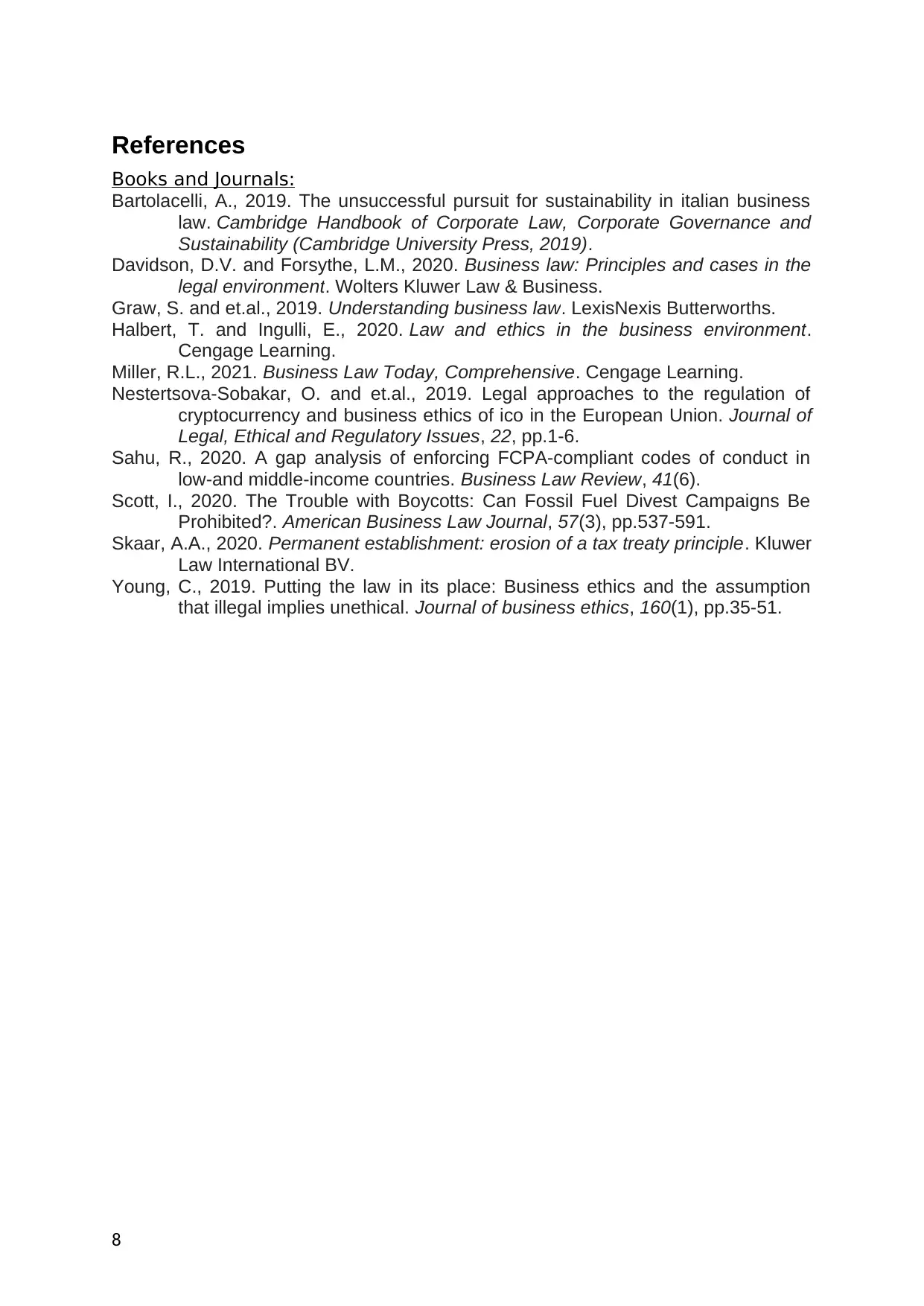
References
Books and Journals:
Bartolacelli, A., 2019. The unsuccessful pursuit for sustainability in italian business
law. Cambridge Handbook of Corporate Law, Corporate Governance and
Sustainability (Cambridge University Press, 2019).
Davidson, D.V. and Forsythe, L.M., 2020. Business law: Principles and cases in the
legal environment. Wolters Kluwer Law & Business.
Graw, S. and et.al., 2019. Understanding business law. LexisNexis Butterworths.
Halbert, T. and Ingulli, E., 2020. Law and ethics in the business environment.
Cengage Learning.
Miller, R.L., 2021. Business Law Today, Comprehensive. Cengage Learning.
Nestertsova-Sobakar, O. and et.al., 2019. Legal approaches to the regulation of
cryptocurrency and business ethics of ico in the European Union. Journal of
Legal, Ethical and Regulatory Issues, 22, pp.1-6.
Sahu, R., 2020. A gap analysis of enforcing FCPA-compliant codes of conduct in
low-and middle-income countries. Business Law Review, 41(6).
Scott, I., 2020. The Trouble with Boycotts: Can Fossil Fuel Divest Campaigns Be
Prohibited?. American Business Law Journal, 57(3), pp.537-591.
Skaar, A.A., 2020. Permanent establishment: erosion of a tax treaty principle. Kluwer
Law International BV.
Young, C., 2019. Putting the law in its place: Business ethics and the assumption
that illegal implies unethical. Journal of business ethics, 160(1), pp.35-51.
8
Books and Journals:
Bartolacelli, A., 2019. The unsuccessful pursuit for sustainability in italian business
law. Cambridge Handbook of Corporate Law, Corporate Governance and
Sustainability (Cambridge University Press, 2019).
Davidson, D.V. and Forsythe, L.M., 2020. Business law: Principles and cases in the
legal environment. Wolters Kluwer Law & Business.
Graw, S. and et.al., 2019. Understanding business law. LexisNexis Butterworths.
Halbert, T. and Ingulli, E., 2020. Law and ethics in the business environment.
Cengage Learning.
Miller, R.L., 2021. Business Law Today, Comprehensive. Cengage Learning.
Nestertsova-Sobakar, O. and et.al., 2019. Legal approaches to the regulation of
cryptocurrency and business ethics of ico in the European Union. Journal of
Legal, Ethical and Regulatory Issues, 22, pp.1-6.
Sahu, R., 2020. A gap analysis of enforcing FCPA-compliant codes of conduct in
low-and middle-income countries. Business Law Review, 41(6).
Scott, I., 2020. The Trouble with Boycotts: Can Fossil Fuel Divest Campaigns Be
Prohibited?. American Business Law Journal, 57(3), pp.537-591.
Skaar, A.A., 2020. Permanent establishment: erosion of a tax treaty principle. Kluwer
Law International BV.
Young, C., 2019. Putting the law in its place: Business ethics and the assumption
that illegal implies unethical. Journal of business ethics, 160(1), pp.35-51.
8
1 out of 8
Related Documents
Your All-in-One AI-Powered Toolkit for Academic Success.
+13062052269
info@desklib.com
Available 24*7 on WhatsApp / Email
![[object Object]](/_next/static/media/star-bottom.7253800d.svg)
Unlock your academic potential
Copyright © 2020–2025 A2Z Services. All Rights Reserved. Developed and managed by ZUCOL.
